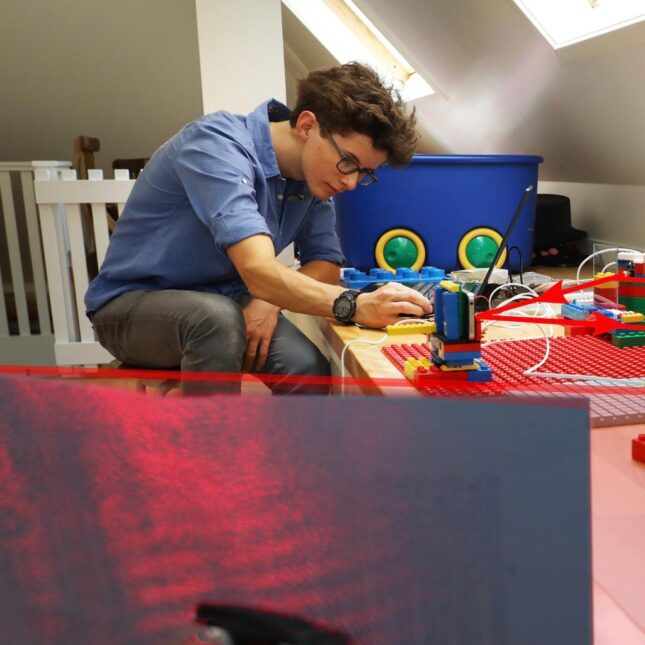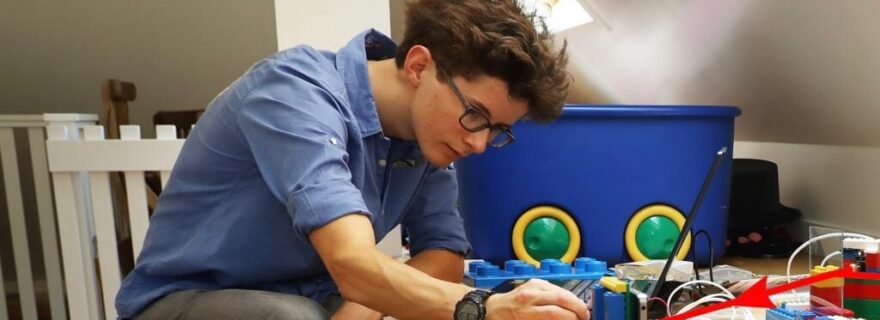Leiden Student Journal: A lab at home
In Leiden Student Journal LSM features a student whose research or internship has lead to a scientific publication. In this article: the LEGO-interferometer of Louw Feenstra.
During the lockdowns many people had to work from home. If your job usually takes place in a lab, that can be a bit of a challenge. Louw Feenstra however showed it is definitely not impossible. What you need? Amongst some other things: a box of LEGOs, iPhones, glass plates, an ice cube and a laser pen. Not only was Louw able to perform his experiment from home, he also got to publish it in Physics Education.
During the first year of his Bachelor Physics and Astronomy, Louw had to perform various experiments, spread out over six courses. By the time he got to his fifth experiment he was, due to lockdown, sent home with a laser pen: he needed to continue his work from home. He decided to set up an experiment with light.
“I thought to myself, I’m going to pretend my house is the lab. I came up with the idea of recreating an interferometer. The idea is that a wave of light can be split into two paths, which can then be brought together again. When the two paths come together, they can enhance or weaken each other, depending on the relative length of the paths. This way it is possible to measure lengths in the order of the wavelength (100 nanometer). The goal of my experiment was to measure the influence of temperature on the wavelength in air,” Louw explains. “The basic construction for this I made out of LEGO, with the laser pen as a light source. I used glass to split the beam of the laser, because glass let's part of a light beam through, but it reflects a part as well. This is something you can see clearly if you’re sitting inside in the evening and a lamp is reflected in the window. To create a difference in temperature, I also used an ice cube in a styrofoam box. I also needed to reflect the splitted beams to bring them back together. Many mirrors you might have at home are not very suitable for this, because they have a layer of glass in front of it. At first I tried using a makeup mirror for example, but that didn’t work and aluminium foil was not reflective enough. Then I came up with the idea of using an old iPhone. The Apple logo on the phone is namely a direct mirror. This worked very well!”

Now the experimenting could start. Louw had a temperature- and light sensor attached to an Arduino computer to measure the temperature inside the box and the enhancement or weakening of the light. Adjusting and fine-tuning of the mirrors and glass plates to be able to accurately measure turned out to be time consuming. Louw did this using Lego wheels on an axis. Due to the angular shape of the iPhones these could be easily placed on top of the wheels in a holder made of LEGO. The entire process of building the setup and performing measurements took Louw 24 hours in total. That was however not the end of it: his setup was functional and he later rebuilt it to perform new measurements for his publication. A video was also made of him, which can now be seen on YouTube.
“Despite not being able to measure the influence of temperature on the wavelength of the laser, I did succeed in performing measurements with my homemade interferometer. That was a discovery in itself! My teacher suggested writing an article about it. I therefore had to build the construction again to do some new measurements. It wasn’t stable enough to measure the desired effect, but I was able to prove that my setup works.”
Louw had made his construction in the attic, which he could easily darken. There was also less noise pollution, causing vibrations, than in the rest of the house, so measurements weren’t disrupted as much. If he was going to do an experiment, he asked everyone in the house to be quiet and he left the room after starting the measurement.
“I learned a lot from my research. I now know how to align an interferometer and I’m still using that knowledge. Writing an article was a very valuable learning experience as well. My teacher played a great role in this. We spoke via Microsoft Teams a lot. My father also helped me a great deal, he has studied physics as well.”
Already in high school Louw was interested in physics. The combination of physics and astronomy at Leiden University appealed to him then. The more he studied, the more he learned that his passion lies in fundamental physics.
“I very much enjoy experimenting and the practical part of physics. I really like the building and the puzzle solving that comes with it. I would love to do a master’s in that direction as well, and I can also see myself doing a PhD. What exactly it is I want to do with physics I don’t know yet. Besides doing experiments I would also like to work in the classroom.”
Louw’s advice for other students that have the ambition to publish an article: “If you’re performing research, you need to accept that it’s not going to be 100% perfect. You can’t keep making endless improvements. Instead you might be able to inspire others for further research!”
Are you curious about the interferometer Louw built? Watch it here:
https://www.youtube.com/watch?v=kSzgz0CJ80o&ab_channel=LeidenInstituteofPhysics



0 Comments
Add a comment